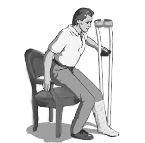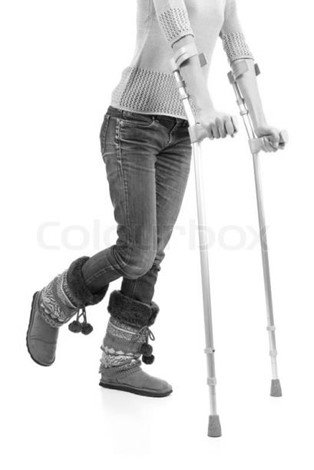How to use crutches
This page gives you instructions about the safe use of crutches.
Please read the information on this page carefully as it is important that you use your crutches safely and correctly to avoid any delay in your recovery. When you are issued with crutches, the hospital staff will adjust them for your height. Using crutches at the wrong height can lead to back pain. If you keep the handles pointing forwards and your arms close to your sides you will be safer and use less energy when moving.
Getting started
To stand:
- Hold both crutches in one hand.
- Push up from the chair.
- Once standing, transfer one crutch into the other hand.
- Put the crutches in front of you and get your balance.

Figure 1: Pushing up from a chair
To sit:
- Have the chair immediately behind you so you are able to feel the edge of the chair against the back of your knees.
- Put both crutches in one hand.
- Hold the chair arm with the other hand.
- Sit down gently.
Preparing to walk
If you have been advised NOT to stand on your injured leg:
- Stand with the handles pointing forward and your arms by your side.
- Put your crutches forward together.
- Keep your injured leg off the ground and in front of you, with your knee slightly bent and your foot behind you.
- Take your weight on your hands and through your arms.
- Bring your good leg forward, just past the crutches, to help keep you balanced.
- Repeat from step 2.
If you have been advised to stand on your injured leg:
- Stand with the handles pointing forward and your arms by your side.
- Put both crutches forward.
- Put your injured leg one step forward taking some weight through your foot. The amount of weight you put through your foot will change as things improve and you have less pain. It is important to follow this advice to prevent long term ankle problem.
- Take your weight onto your hands and step further through with your good leg.
- Put both crutches forward and repeat from step 2.

Figure 2: Non weight bearing
Managing stairs
The safest way to go up and down stairs is to use your bottom, not your crutches. If you need to use your crutches and there is a suitable handrail you should hold this with one hand and your crutches in the other to take your weight.
- Going up: Good leg, bad leg, crutch.
- Going down: Crutch, bad leg, good leg.
Safety advice
- Wear flat supportive shoes.
- Use a chair with a high seat and arms to help you sit and stand up with ease.
- Remove obstacles in your home such as loose rugs.
- Avoid wet floors.
- Make sure that the area/room is well lit.
- Beware of hazards including doors/ uneven surfaces, wet leaves and ice.
- Regularly inspect your crutches for wear, bent or damaged tubes or loose rivets.
- Make sure that the pin adjustment holes, used to alter crutch length, are not worn.
- Check that the rubber ends are not worn or clogged with dirt or stones.
When you no longer need your crutches they must be returned to GIS Healthcare or you will be charged for them. GIS can be contacted to arrange collection; the contact details are at the end of this page.
Further information
All X-rays are reviewed and you will be contacted if there are any concerns. However, if you feel your symptoms are not improving or your pain is increasing, you should contact NHS 111 for advice.
Contact information
Orthopaedic Outpatients
Cheltenham General Hospital
Tel: 0300 422 3147
Monday to Friday, 8:00am to 4:00pm
Gloucestershire Royal Hospital
Tel: 0300 422 6137
Monday to Friday, 8:00am to 4:00pm
GIS Healthcare
Severnside Trading Estate, Sudmeadow Road, Hempsted, Gloucester GL2 5HS
Tel: 01452 520438
Monday to Friday, 8:30am to 4:30pm